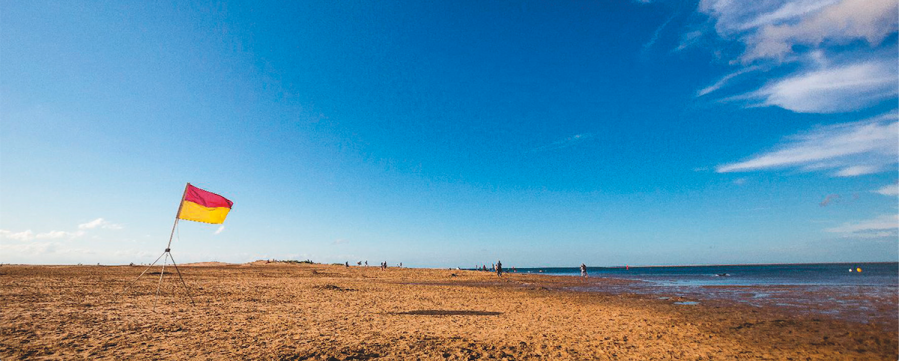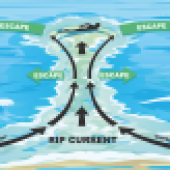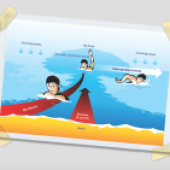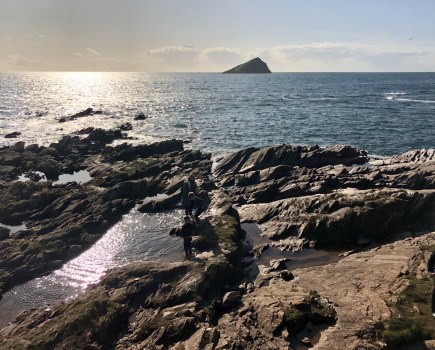Britain’s coastline is blessed with stunning seaside spots for all the family to enjoy, but the sea is powerful so refresh your memory about the hidden dangers and how to deal with them. Words: Karl West. Photographs: Nathan Williams, Adrian Don, Dom Stephens, RNLI
According to the two biggest beach safety and drowning prevention charities in Britain – the Royal National Lifeboat Institution (RNLI) and the Royal Life Saving Society UK (RLSS) – the greatest threat to a typical family trip to the seaside probably won’t come from sharks or jellyfish, but from rip currents, tides and offshore winds. These may not sound as menacing, but each year more visitors to Britain’s beaches get into trouble because of them than anything else.
BEWARE RIP CURRENTS
Rip currents are like powerful rivers in the sea that usually rush back from the shore and out to deeper water. They are dangerous because they are stronger and faster than even the best swimmer and can quickly sweep unwary swimmers, surfers and body-boarders out to sea. These rip currents may appear as dark water, as calm areas in between waves, or as choppy areas. Any time you see beach debris, such as seaweed, and foam floating out to sea, chances are you have spotted a rip current. It’s always best to choose a beach with lifeguards but if this isn’t possible avoid the area, and, if in doubt, don’t go out.
It is easy to get caught in a rip current. Experts reckon it happens most often in waist-deep water. Both the RNLI and RLSS advise those caught in a rip current to stay calm and conserve energy. A rip current is like a giant water treadmill that you can’t turn off, so it does no good to try and swim against it. If you find yourself in a rip, raise your hand and shout for help. Stronger swimmers can try to escape by swimming sideways across the rip, which is usually parallel with the beach. As a last resort, if you float or tread water you will eventually wash out of the current as the rip moves to deeper water and you can swim back to shore taking a diagonal line to avoid going back into the current. For more info go to ripcurrents.co.uk.
CHECK THE TIDES
Incoming tides isolate rocks and sandbanks from headlands and the shore. So, before strolling out to a secluded headland, find out what time the tide rolls back in. Be vigilant if you are going to venture into such areas – the tide can quickly come in, and without realising it you’ve been cut off.
Free tide tables are readily available at most beaches or displayed on the lifeguard tower. Stay off rocks and small, enclosed beaches and know the tide times to avoid getting stranded. Also, rocks can be slippery, even when it isn’t raining, so keep to paths and avoid walking close to cliff edges in high winds.
UNDERSTAND OFFSHORE WINDS
Offshore winds blow across the land and towards the sea. They are favoured by surfers as they produce better waves – but they can be dangerous for unassuming beach-goers who just want to paddle around the bay in an inflatable dinghy or on a lilo. Children using inflatables should always be accompanied by an adult standing in the water, who can hold on to them. These air beds and inflatable boats are a well-known hazard.
Drownings occur when people don’t pay proper attention to the wind direction, as inflatables are easily blown far out to sea. The RLSS advises against their use in open water and recommends that they should only be used in sheltered and confined spaces, such as rockpools or seaside lidos, if permitted.
Find out more at rnli.org/safety/respect-the-water.
NEED TO KNOW
THE RNLI LISTS OVER 200 BRITISH ISLE BEACHES that are patrolled by RNLI lifeguards (rnli.org); the information is also on The Good Beach Guide website run by the Marine Conservation Society (goodbeachguide.co.uk).
KNOW YOUR FLAGS. Ask the beach lifeguards about dangers and the safest places to swim – usually between red and yellow striped flags. Areas between black and white chequered flags are for water-sports only, so don’t swim or body-board there. If the red flag is flying, it isn’t safe to go in the water.
ALWAYS SWIM PARALLEL to the shore, close to the beach, where you can quickly get to safety. Go into the water with someone who can help if you get into trouble.
STAY CLOSE TO CHILDREN in the sea at all times, even in the shallows when they’re paddling. If you’re unsure about conditions on the beach you’re visiting, call the local tourist office for advice.
IF YOU GET INTO TROUBLE in the sea raise your hand and shout for help. If you’re a worried onlooker, alert the beach lifeguards, or call 999 and ask for the Coastguard.
Britain’s coastline is blessed with stunning seaside spots for all the family to enjoy, but the sea is powerful so refresh your memory about the hidden dangers and how to deal with them. Words: Karl West. Photographs: Nathan Williams, Adrian Don, Dom Stephens, RNLI
According to the two biggest beach safety and drowning prevention charities in Britain – the Royal National Lifeboat Institution (RNLI) and the Royal Life Saving Society UK (RLSS) – the greatest threat to a typical family trip to the seaside probably won’t come from sharks or jellyfish, but from rip currents, tides and offshore winds. These may not sound as menacing, but each year more visitors to Britain’s beaches get into trouble because of them than anything else.
BEWARE RIP CURRENTS
Rip currents are like powerful rivers in the sea that usually rush back from the shore and out to deeper water. They are dangerous because they are stronger and faster than even the best swimmer and can quickly sweep unwary swimmers, surfers and body-boarders out to sea. These rip currents may appear as dark water, as calm areas in between waves, or as choppy areas. Any time you see beach debris, such as seaweed, and foam floating out to sea, chances are you have spotted a rip current. It’s always best to choose a beach with lifeguards but if this isn’t possible avoid the area, and, if in doubt, don’t go out.
It is easy to get caught in a rip current. Experts reckon it happens most often in waist-deep water. Both the RNLI and RLSS advise those caught in a rip current to stay calm and conserve energy. A rip current is like a giant water treadmill that you can’t turn off, so it does no good to try and swim against it. If you find yourself in a rip, raise your hand and shout for help. Stronger swimmers can try to escape by swimming sideways across the rip, which is usually parallel with the beach. As a last resort, if you float or tread water you will eventually wash out of the current as the rip moves to deeper water and you can swim back to shore taking a diagonal line to avoid going back into the current. For more info go to ripcurrents.co.uk.
CHECK THE TIDES
Incoming tides isolate rocks and sandbanks from headlands and the shore. So, before strolling out to a secluded headland, find out what time the tide rolls back in. Be vigilant if you are going to venture into such areas – the tide can quickly come in, and without realising it you’ve been cut off.
Free tide tables are readily available at most beaches or displayed on the lifeguard tower. Stay off rocks and small, enclosed beaches and know the tide times to avoid getting stranded. Also, rocks can be slippery, even when it isn’t raining, so keep to paths and avoid walking close to cliff edges in high winds.
UNDERSTAND OFFSHORE WINDS
Offshore winds blow across the land and towards the sea. They are favoured by surfers as they produce better waves – but they can be dangerous for unassuming beach-goers who just want to paddle around the bay in an inflatable dinghy or on a lilo. Children using inflatables should always be accompanied by an adult standing in the water, who can hold on to them. These air beds and inflatable boats are a well-known hazard.
Drownings occur when people don’t pay proper attention to the wind direction, as inflatables are easily blown far out to sea. The RLSS advises against their use in open water and recommends that they should only be used in sheltered and confined spaces, such as rockpools or seaside lidos, if permitted.
Find out more at rnli.org/safety/respect-the-water.
NEED TO KNOW
THE RNLI LISTS OVER 200 BRITISH ISLE BEACHES that are patrolled by RNLI lifeguards (rnli.org); the information is also on The Good Beach Guide website run by the Marine Conservation Society (goodbeachguide.co.uk).
KNOW YOUR FLAGS. Ask the beach lifeguards about dangers and the safest places to swim – usually between red and yellow striped flags. Areas between black and white chequered flags are for water-sports only, so don’t swim or body-board there. If the red flag is flying, it isn’t safe to go in the water.
ALWAYS SWIM PARALLEL to the shore, close to the beach, where you can quickly get to safety. Go into the water with someone who can help if you get into trouble.
STAY CLOSE TO CHILDREN in the sea at all times, even in the shallows when they’re paddling. If you’re unsure about conditions on the beach you’re visiting, call the local tourist office for advice.
IF YOU GET INTO TROUBLE in the sea raise your hand and shout for help. If you’re a worried onlooker, alert the beach lifeguards, or call 999 and ask for the Coastguard.











